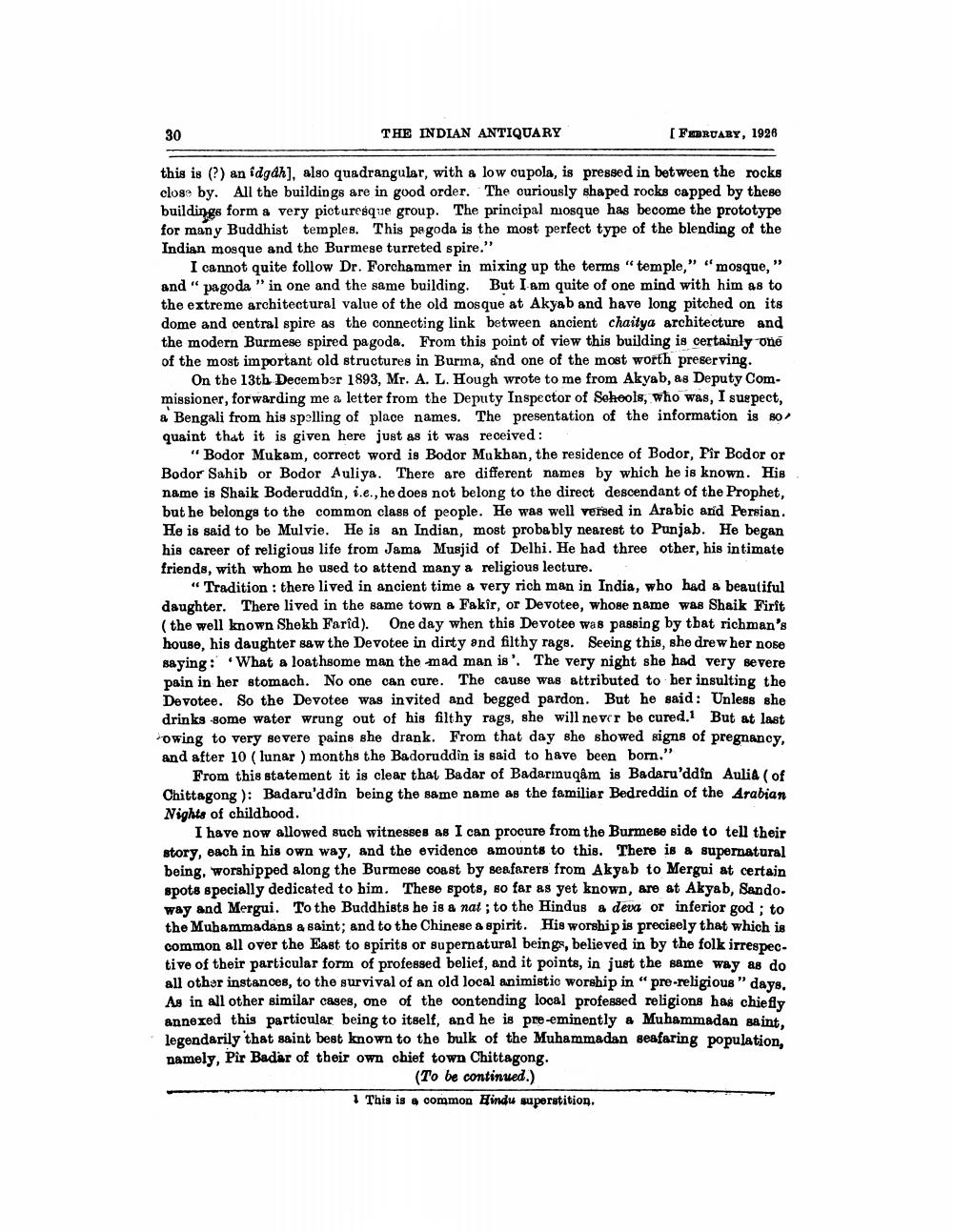________________
30
THE INDIAN ANTIQUARY
[ FEBRUARY, 1926
this is (?) an idgah), algo quadrangular, with a low ou pola, is pressed in between the rocks close by. All the buildings are in good order. The curiously shaped rocks capped by these buildings form a very picturesque group. The principal mosque has become the prototype for many Buddhist temples. This pagoda is the most perfect type of the blending of the Indian mosque and the Burmese turreted spire."
I cannot quite follow Dr. Forchammer in mixing up the terms "temple," "mosque," and" pagoda " in one and the same building. But I am quite of one mind with him as to the extreme architectural value of the old mosque at Akyab and have long pitched on its dome and oentral spire as the connecting link between ancient chaitya architecture and the modern Burmese spired pa goda. From this point of view this building is certainly one of the most important old structures in Burma, and one of the most worth preserving.
On the 13th December 1893, Mr. A. L. Hough wrote to me from Akyab, ag Deputy Commissioner, forwarding me a letter from the Deputy Inspector of Schools, who was, I suspect, a Bengali from his spelling of place names. The presentation of the information is 80 quaint that it is given here just as it was received:
"Bodor Mukam, correct word is Bodor Mukhan, the residence of Bodor, Fir Bodor or Bodor Sahib or Bodor Auliya. There are different names by which he is known. His name is Shaik Boderuddin, i.e., he does not belong to the direct descendant of the Prophet, but he belongs to the common class of people. He was well versed in Arabic arid Persian. He is said to be Mulvie. He is an Indian, most probably nearest to Punjab. He began his career of religious life from Jama Musjid of Delhi. He had three other, his intimate friends, with whom ho used to attend many a religious lecture.
"Tradition : there lived in ancient time a very rich man in India, who had a beautiful daughter. There lived in the same town a Fakir, or Devotee, whose name was Shaik Firit (the well known Shekh Farid). One day when this Devotee was passing by tbat richman's house, his daughter saw the Devotee in dirty and filthy rage. Seeing this, she drew her nose saying: What a loathsome man the mad man is'. The very night she had very severe pain in her stomach. No one can cure. The cause was attributed to her insulting the Devotee. So the Devotee was invited and begged pardon. But he said: Unless she drinks some water wrung out of his filthy rags, she will never be cured. But at last owing to very severe pains she drank. From that day she showed signs of pregnancy, and after 10 ( lunar ) months the Badoruddin is said to have been born."
From this statement it is clear that Badar of Badarıuqam is Badaru'ddin Aulia (of Chittagong ): Badaru'ddin being the same name as the familiar Bedreddin of the Arabian Nights of childhood.
I have now allowed such witnesses as I can procure from the Burmese side to tell their story, each in his own way, and the evidence amounts to this. There is & supernatural being, worshipped along the Burmese coast by seafarers from Akyab to Mergui at certain spots specially dedicated to bim. These spots, so far as yet known, are at Akyab, Sando. way and Mergui. To the Buddhists he is a nat; to the Hindus & deva or inferior god; to the Muhammadans a saint; and to the Chinese & spirit. His worship is precisely that which is common all over the East to spirits or supernatural beings, believed in by the folk irrespective of their particular form of professed belief, and it points, in just the same way as do all other instances, to the survival of an old local animistic worship in “pre-religious" days. As in all other similar cases, one of the contending local professed religions has chiefly annexed this particular being to itself, and he is pre-eminently a Muhammadan saint, legendarily that saint best known to the bulk of the Muhammadan seafaring population, namely, Pir Badar of their own chief town Chittagong.
(To be continued.) 1 This is a common Hindu superstition.




